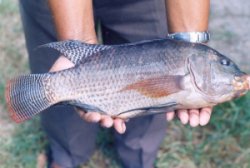
EARTH FLAVOR IN TILAPIA
From March to August, it is common to find freshwater tilapia to have a taste like soil or earth. It was researched on and found out that at UP Los Baños as well as SEAFDEC, Iloilo, that this is caused by a kind of water plant or seaweed that the tilapia eat.
This earthy taste can be removed if the fish is soaked in pure lambanog (coconut or palm wine) one hour before cooking. At SEAFDEC, the dish are raised first in a tank where they are deprived of food for six hours, to cleanse their intestines. Then these are transferred to another tank for 3 days, where the water is changed several times until the earthy taste is gone. This lasts from one to two weeks.
GOOD BREEDING FOR FISH
To breed fish, the following should be considered, as tried by experts:
- The depth level of the pond must be lower than that of the sea or river to allow water to enter the pond level at low tide.
- The bottom of the breeding pond must consist of lime or compost, about 16%.The pH must be between 7-8. ( Consult the Bureau of Soils)
- The bottom earth must be clayey so as to retain water.
- There must be two outlets to facilitate the entrance and outgoing of water.
- One part of the bottom must be a little higher than the other side to make harvest of fish easy.
- Dig canals around 15 cm. deep around the pond for water to flow in. This will provide outlet for dirt and other things that may fall into the dike.
- The dike should be strong against the pressure of water from the crabs and eels that may destroy and enlarge its holes, and high enough to protect from overflow during strong rain.
LIME FOR FISH PONDS
Fishes In Europe and Asia, fish raisers have learned that the application of lime on fish ponds help a lot in the growth and reproduction of the fish therein, especially in water levels that have low calcium content. Like the application of fertilizer, lime is applied on the ponds. The most commonly available are those used on land—ground lime, and either calcite (CaCO3) or dolomite (CaMg (CO3)2).
As early as 1975, this has been studied in the Auburn University of Alabama (USA) on five fishponds that were treated with lime and five others not treated with lime but fertilized with ammonium nitrate and trisuperphosphate every two weeks. It was seen that plants growing in the ponds with lime flourished, and the fish increased by 25%. This was also tried in Malaysia as early as 1962 where the tilapia they raised in ponds increased by 10% with the application of lime.
ACIDIC FISHPOND
After a strong rain, it is common to see dead fish floating on a fish pond. This is because of poisoning from the acid coming from the ponds bottom. This is common among soils that contains much sulfur or sulfide compound. According to researchers, when this kind of soil is exposed to the air in summer, its sulfur content mixes with the oxygen in the air and becomes poisonous sulfuric acid( that is lethal even to humans).
When it rains, the water becomes poison for the fish because acid in the water activated some substances like iron and aluminum, which mingles with the water. In such cases, water in the fish pond should first be analyzed at the Bureau of Soils. The remedy for this is to apply lime and animal manure to counteract the existing acid.
source: Local Government Unit of Sorsogo
Related Links:
Agri Business
No comments:
Post a Comment